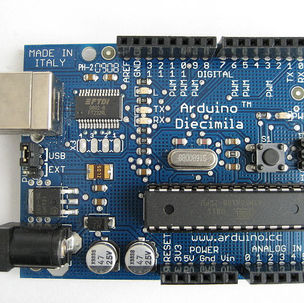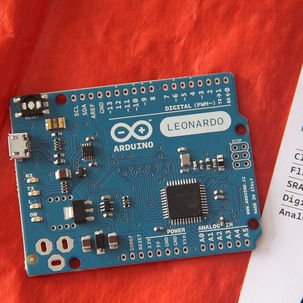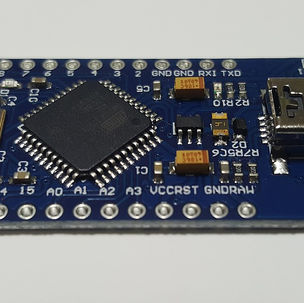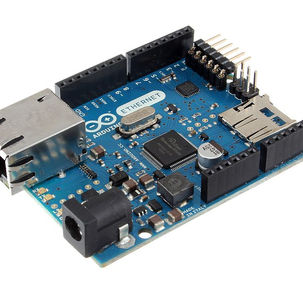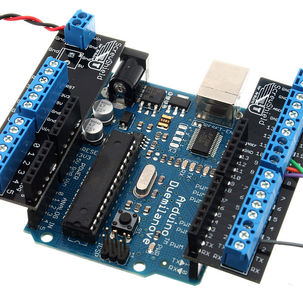Brain Matter Upgrade 2
Electronics
..
Electronics comprises the physics, engineering, technology and applications that deal with the emission, flow and control of electrons in vacuum and matter.[1]
It uses active devices to control electron flow by amplification and rectification, which distinguishes it from classical electrical engineering which uses passive effects such as resistance, capacitance and inductance to control current flow. Electronics has had a major effect on the development of modern society. The identification of the electron in 1897, along with the subsequent invention of the vacuum tube which could amplify and rectify small electrical signals, inaugurated the field of electronics and the electron age.[2] This distinction started around 1906 with the invention by Lee De Forest of the triode, which made electrical amplification of weak radio signals and audio signals possible with a non-mechanical device. Until 1950, this field was called "radio technology" because its principal application was the design and theory of radio transmitters, receivers, and vacuum tubes.
The term "solid-state electronics" emerged after the first working transistor was invented by William Shockley, Walter Houser Brattain and John Bardeen at Bell Labs in 1947. The MOSFET (MOS transistor) was later invented by Mohamed Atalla and Dawon Kahng at Bell Labs in 1959. The MOSFET was the first truly compact transistor that could be miniaturised and mass-produced for a wide range of uses, revolutionizing the electronics industry, and playing a central role in the microelectronics revolution and Digital Revolution. The MOSFET has since become the basic element in most modern electronic equipment, and is the most widely used electronic device in the world.
Electronics is widely used in information processing, telecommunication, and signal processing. The ability of electronic devices to act as switches makes digital information-processing possible. Interconnection technologies such as circuit boards, electronics packaging technology, and other varied forms of communication infrastructure complete circuit functionality and transform the mixed electronic components into a regular working system, called an electronic system; examples are computers or control systems. An electronic system may be a component of another engineered system or a standalone device. As of 2019 most electronic devices[3] use semiconductor components to perform electron control. Commonly, electronic devices contain circuitry consisting of active semiconductors supplemented with passive elements; such a circuit is described as an electronic circuit. Electronics deals with electrical circuits that involve active electrical components such as vacuum tubes, transistors, diodes, integrated circuits, optoelectronics, and sensors, associated passive electrical components, and interconnection technologies. The nonlinear behaviour of active components and their ability to control electron flows makes amplification of weak signals possible.
The study of semiconductor devices and related technology is considered a branch of solid-state physics, whereas the design and construction of electronic circuits to solve practical problems come under electronics engineering. This article focuses on engineering aspects of electronics.
Contents
Branches of electronics
Electronics has branches as follows:
Electronic devices and components
One of the earliest Audion radio receivers, constructed by De Forest in 1914.
Electronics Technician performing a voltage check on a power circuit card in the air navigation equipment room aboard the aircraft carrier USS Abraham Lincoln (CVN 72).
Main article: Electronic component
An electronic component is any physical entity in an electronic system used to affect the electrons or their associated fields in a manner consistent with the intended function of the electronic system. Components are generally intended to be connected together, usually by being soldered to a printed circuit board (PCB), to create an electronic circuit with a particular function (for example an amplifier, radio receiver, or oscillator). Components may be packaged singly, or in more complex groups as integrated circuits. Some common electronic components are capacitors, inductors, resistors, diodes, transistors, etc. Components are often categorized as active (e.g. transistors and thyristors) or passive (e.g. resistors, diodes, inductors and capacitors).[4]
History of electronic components
See also: History of electronic engineering and Timeline of electrical and electronic engineering
Vacuum tubes (Thermionic valves) were among the earliest electronic components.[5] They were almost solely responsible for the electronics revolution of the first half of the twentieth century.[6][7] They allowed for vastly more complicated systems and gave us radio, television, phonographs, radar, long-distance telephony and much more. They played a leading role in the field of microwave and high power transmission as well as television receivers until the middle of the 1980s.[8] Since that time, solid-state devices have all but completely taken over. Vacuum tubes are still used in some specialist applications such as high power RF amplifiers, cathode ray tubes, specialist audio equipment, guitar amplifiers and some microwave devices.
The first working point-contact transistor was invented by John Bardeen and Walter Houser Brattain at Bell Labs in 1947.[9] In April 1955, the IBM 608 was the first IBM product to use transistor circuits without any vacuum tubes and is believed to be the first all-transistorized calculator to be manufactured for the commercial market.[10][11] The 608 contained more than 3,000 germanium transistors. Thomas J. Watson Jr. ordered all future IBM products to use transistors in their design. From that time on transistors were almost exclusively used for computer logic and peripherals. However, early junction transistors were relatively bulky devices that were difficult to manufacture on a mass-production basis, which limited them to a number of specialised applications.[12]
The MOSFET (MOS transistor) was invented by Mohamed Atalla and Dawon Kahng at Bell Labs in 1959.[13][14][15][16] The MOSFET was the first truly compact transistor that could be miniaturised and mass-produced for a wide range of uses.[12] Its advantages include high scalability,[17] affordability,[18] low power consumption, and high density.[19] It revolutionized the electronics industry,[20][21] becoming the most widely used electronic device in the world.[15][22] The MOSFET is the basic element in most modern electronic equipment,[23][24] and has been central to the electronics revolution,[25] the microelectronics revolution,[26] and the Digital Revolution.[16][27][28][29] The MOSFET has thus been credited as the birth of modern electronics,[30][31] and possibly the most important invention in electronics.[32]
Types of circuits
Circuits and components can be divided into two groups: analog and digital. A particular device may consist of circuitry that has one or the other or a mix of the two types.
Analog circuits
Main article: Analog electronics
Hitachi J100 adjustable frequency drive chassis
Most analog electronic appliances, such as radio receivers, are constructed from combinations of a few types of basic circuits. Analog circuits use a continuous range of voltage or current as opposed to discrete levels as in digital circuits.
The number of different analog circuits so far devised is huge, especially because a 'circuit' can be defined as anything from a single component, to systems containing thousands of components.
Analog circuits are sometimes called linear circuits although many non-linear effects are used in analog circuits such as mixers, modulators, etc. Good examples of analog circuits include vacuum tube and transistor amplifiers, operational amplifiers and oscillators.
One rarely finds modern circuits that are entirely analog. These days analog circuitry may use digital or even microprocessor techniques to improve performance. This type of circuit is usually called "mixed signal" rather than analog or digital.
Sometimes it may be difficult to differentiate between analog and digital circuits as they have elements of both linear and non-linear operation. An example is the comparator which takes in a continuous range of voltage but only outputs one of two levels as in a digital circuit. Similarly, an overdriven transistor amplifier can take on the characteristics of a controlled switch having essentially two levels of output. In fact, many digital circuits are actually implemented as variations of analog circuits similar to this example – after all, all aspects of the real physical world are essentially analog, so digital effects are only realized by constraining analog behavior.
Digital circuits
Main article: Digital electronics
Digital circuits are electric circuits based on a number of discrete voltage levels. Digital circuits are the most common physical representation of Boolean algebra, and are the basis of all digital computers. To most engineers, the terms "digital circuit", "digital system" and "logic" are interchangeable in the context of digital circuits. Most digital circuits use a binary system with two voltage levels labeled "0" and "1". Often logic "0" will be a lower voltage and referred to as "Low" while logic "1" is referred to as "High". However, some systems use the reverse definition ("0" is "High") or are current based. Quite often the logic designer may reverse these definitions from one circuit to the next as he sees fit to facilitate his design. The definition of the levels as "0" or "1" is arbitrary.
Ternary (with three states) logic has been studied, and some prototype computers made.
Computers, electronic clocks, and programmable logic controllers (used to control industrial processes) are constructed of digital circuits. Digital signal processors are another example.
Building blocks:
Highly integrated devices:
-
Digital signal processor (DSP)
Heat dissipation and thermal management
Main article: Thermal management of electronic devices and systems
Heat generated by electronic circuitry must be dissipated to prevent immediate failure and improve long term reliability. Heat dissipation is mostly achieved by passive conduction/convection. Means to achieve greater dissipation include heat sinks and fans for air cooling, and other forms of computer cooling such as water cooling. These techniques use convection, conduction, and radiation of heat energy.
Noise
Main article: Electronic noise
Electronic noise is defined[33] as unwanted disturbances superposed on a useful signal that tend to obscure its information content. Noise is not the same as signal distortion caused by a circuit. Noise is associated with all electronic circuits. Noise may be electromagnetically or thermally generated, which can be decreased by lowering the operating temperature of the circuit. Other types of noise, such as shot noise cannot be removed as they are due to limitations in physical properties.
Electronics theory
Main article: Mathematical methods in electronics
Mathematical methods are integral to the study of electronics. To become proficient in electronics it is also necessary to become proficient in the mathematics of circuit analysis.
Circuit analysis is the study of methods of solving generally linear systems for unknown variables such as the voltage at a certain node or the current through a certain branch of a network. A common analytical tool for this is the SPICE circuit simulator.
Also important to electronics is the study and understanding of electromagnetic field theory.
Electronics lab
Main article: Electronic circuit simulation
Due to the complex nature of electronics theory, laboratory experimentation is an important part of the development of electronic devices. These experiments are used to test or verify the engineer's design and detect errors. Historically, electronics labs have consisted of electronics devices and equipment located in a physical space, although in more recent years the trend has been towards electronics lab simulation software, such as CircuitLogix, Multisim, and PSpice.
Computer aided design (CAD)
Main article: Electronic design automation
Today's electronics engineers have the ability to design circuits using premanufactured building blocks such as power supplies, semiconductors (i.e. semiconductor devices, such as transistors), and integrated circuits. Electronic design automation software programs include schematic capture programs and printed circuit board design programs. Popular names in the EDA software world are NI Multisim, Cadence (ORCAD), EAGLE PCB and Schematic, Mentor (PADS PCB and LOGIC Schematic), Altium (Protel), LabCentre Electronics (Proteus), gEDA, KiCad and many others.
Packaging methods
Main article: Electronic packaging
Many different methods of connecting components have been used over the years. For instance, early electronics often used point to point wiring with components attached to wooden breadboards to construct circuits. Cordwood construction and wire wrap were other methods used. Most modern day electronics now use printed circuit boards made of materials such as FR4, or the cheaper (and less hard-wearing) Synthetic Resin Bonded Paper (SRBP, also known as Paxoline/Paxolin (trade marks) and FR2) – characterised by its brown colour. Health and environmental concerns associated with electronics assembly have gained increased attention in recent years, especially for products destined to the European Union, with its Restriction of Hazardous Substances Directive (RoHS) and Waste Electrical and Electronic Equipment Directive (WEEE), which went into force in July 2006.
Electronic systems design
Main article: Systems engineering
Electronic systems design deals with the multi-disciplinary design issues of complex electronic devices and systems, such as mobile phones and computers. The subject covers a broad spectrum, from the design and development of an electronic system (new product development) to assuring its proper function, service life and disposal.[34] Electronic systems design is therefore the process of defining and developing complex electronic devices to satisfy specified requirements of the user.
Mounting Options
Electrical components are generally mounted in the following ways:
-
Chassis Mount
Electronics industry
Main article: Electronics industry
Further information: Consumer electronics, List of best-selling electronic devices, and Semiconductor industry
The electronics industry consists of various sectors. The central driving force behind the entire electronics industry is the semiconductor industry sector,[35] which has annual sales of over $481 billion as of 2018.[36] The largest industry sector is e-commerce, which generated over $29 trillion in 2017.[37] The most widely manufactured electronic device is the metal-oxide-semiconductor field-effect transistor (MOSFET), with an estimated 13 sextillion MOSFETs having been manufactured between 1960 and 2018.[38]
See also
Arduino project boards

"LilyPad" redirects here. For other uses, see Lily pad (disambiguation) and Arduino (disambiguation).
Arduino
Arduino Uno SMD R3
Developerarduino.cc
ManufacturerArduino
TypeSingle-board microcontroller
Operating systemNone
CPUAtmel AVR (8-bit),
ARM Cortex-M0+ (32-bit),
ARM Cortex-M3 (32-bit),
Intel Quark (x86) (32-bit)
MemorySRAM
Websitewww.arduino.cc
Arduino (/ɑːˈdwiːnoʊ/) is an open-source hardware and software company, project and user community that designs and manufactures single-board microcontrollers and microcontroller kits for building digital devices. Its hardware products are licensed under a CC-BY-SA license, while software is licensed under the GNU Lesser General Public License (LGPL) or the GNU General Public License (GPL),[1] permitting the manufacture of Arduino boards and software distribution by anyone. Arduino boards are available commercially from the official website or through authorized distributors.
Arduino board designs use a variety of microprocessors and controllers. The boards are equipped with sets of digital and analog input/output (I/O) pins that may be interfaced to various expansion boards ('shields') or breadboards (for prototyping) and other circuits. The boards feature serial communications interfaces, including Universal Serial Bus (USB) on some models, which are also used for loading programs from personal computers. The microcontrollers can be programmed using the C and C++ programming languages, using a standard API which is also known as the "Arduino language". In addition to using traditional compiler toolchains, the Arduino project provides an integrated development environment (IDE) and a command line tool (arduino-cli) developed in Go.
The Arduino project started in 2005 as a tool for students at the Interaction Design Institute Ivrea in Ivrea, Italy,[2] aiming to provide a low-cost and easy way for novices and professionals to create devices that interact with their environment using sensors and actuators. Common examples of such devices intended for beginner hobbyists include simple robots, thermostats and motion detectors.
The name Arduino comes from a bar in Ivrea, Italy, where some of the founders of the project used to meet. The bar was named after Arduin of Ivrea, who was the margrave of the March of Ivrea and King of Italy from 1002 to 1014.[3]
Contents
History
The Arduino project was started at the Interaction Design Institute Ivrea (IDII) in Ivrea, Italy.[2] At that time, the students used a BASIC Stamp microcontroller at a cost of $50, a considerable expense for many students. In 2003 Hernando Barragán created the development platform Wiring as a Master's thesis project at IDII, under the supervision of Massimo Banzi and Casey Reas. Casey Reas is known for co-creating, with Ben Fry, the Processing development platform. The project goal was to create simple, low cost tools for creating digital projects by non-engineers. The Wiring platform consisted of a printed circuit board (PCB) with an ATmega168 microcontroller, an IDE based on Processing and library functions to easily program the microcontroller.[4] In 2005, Massimo Banzi, with David Mellis, another IDII student, and David Cuartielles, extended Wiring by adding support for the cheaper ATmega8 microcontroller. The new project, forked from Wiring, was called Arduino.[4]
The initial Arduino core team consisted of Massimo Banzi, David Cuartielles, Tom Igoe, Gianluca Martino, and David Mellis[2].
Following the completion of the platform, lighter and less expensive versions were distributed in the open-source community. It was estimated in mid-2011 that over 300,000 official Arduinos had been commercially produced,[5] and in 2013 that 700,000 official boards were in users' hands.[6]
Trademark dispute
In early 2008, the five co-founders of the Arduino project created a company, Arduino LLC,[7] to hold the trademarks associated with Arduino. The manufacture and sale of the boards was to be done by external companies, and Arduino LLC would get a royalty from them. The founding bylaws of Arduino LLC specified that each of the five founders transfer ownership of the Arduino brand to the newly formed company.[citation needed]
At the end of 2008, Gianluca Martino's company, Smart Projects, registered the Arduino trademark in Italy and kept this a secret from the other co-founders for about two years. This was revealed when the Arduino company tried to register the trademark in other areas of the world (they originally registered only in the US), and discovered that it was already registered in Italy. Negotiations with Gianluca and his firm to bring the trademark under control of the original Arduino company failed. In 2014, Smart Projects began refusing to pay royalties. They then appointed a new CEO, Federico Musto, who renamed the company Arduino SRL and created the website arduino.org, copying the graphics and layout of the original arduino.cc. This resulted in a rift in the Arduino development team.[8][9][10]
In January 2015, Arduino LLC filed a lawsuit against Arduino SRL.[11]
In May 2015, Arduino LLC created the worldwide trademark Genuino, used as brand name outside the United States.[12]
At the World Maker Faire in New York on 1 October 2016, Arduino LLC co-founder and CEO Massimo Banzi and Arduino SRL CEO Federico Musto announced the merger of the two companies.[13] Around that same time, Massimo Banzi announced that in addition to the company a new Arduino Foundation would be launched as "a new beginning for Arduino.", but this decision was withdrawn later[14].[15]
In April 2017, Wired reported that Musto had "fabricated his academic record.... On his company's website, personal LinkedIn accounts, and even on Italian business documents, Musto was until recently listed as holding a PhD from the Massachusetts Institute of Technology. In some cases, his biography also claimed an MBA from New York University." Wired reported that neither university had any record of Musto's attendance, and Musto later admitted in an interview with Wired that he had never earned those degrees.[16] The controversy surrounding Musto continued when, in July 2017, he reportedly pulled many Open source licenses, schematics, and code from the Arduino website, prompting scrutiny and outcry.[17]
By 2017 Arduino AG owned many Arduino trademarks. In July 2017 BCMI, founded by Massimo Banzi, David Cuartielles, David Mellis and Tom Igoe, acquired Arduino AG and all the Arduino trademarks. Fabio Violante is the new CEO replacing Federico Musto, who no longer works for Arduino AG.[18][19]
Post-dispute
In October 2017, Arduino announced its partnership with ARM Holdings (ARM). The announcement said, in part, "ARM recognized independence as a core value of Arduino ... without any lock-in with the ARM architecture.” Arduino intends to continue to work with all technology vendors and architectures.[20]
Under Violante's guidance, the company started growing again and releasing new designs. The Genuino trademark was dismissed and all products were branded again with the Arduino name. As of February 2020, the Arduino community included about 30 million active users based on the IDE downloads[21].
In August 2018, Arduino announced its new open source command line tool (arduino-cli), which can be used as a replacement of the IDE to program the boards from a shell[22].
In February 2019, Arduino announced its IoT Cloud service as an extension of the Create online environment.[23]
Hardware
Arduino-compatible R3 Uno board made in China with no Arduino logo, but with identical markings, including "Made in Italy" text
Arduino is open-source hardware. The hardware reference designs are distributed under a Creative Commons Attribution Share-Alike 2.5 license and are available on the Arduino website. Layout and production files for some versions of the hardware are also available.
Although the hardware and software designs are freely available under copyleft licenses, the developers have requested the name Arduino to be exclusive to the official product and not be used for derived works without permission. The official policy document on use of the Arduino name emphasizes that the project is open to incorporating work by others into the official product.[24] Several Arduino-compatible products commercially released have avoided the project name by using various names ending in -duino.[25]
An early Arduino board[26] with an RS-232 serial interface (upper left) and an Atmel ATmega8 microcontroller chip (black, lower right); the 14 digital I/O pins are at the top, the 6 analog input pins at the lower right, and the power connector at the lower left.
Most Arduino boards consist of an Atmel 8-bit AVR microcontroller (ATmega8,[27] ATmega168, ATmega328, ATmega1280, or ATmega2560) with varying amounts of flash memory, pins, and features.[28] The 32-bit Arduino Due, based on the Atmel SAM3X8E was introduced in 2012.[29] The boards use single or double-row pins or female headers that facilitate connections for programming and incorporation into other circuits. These may connect with add-on modules termed shields. Multiple and possibly stacked shields may be individually addressable via an I²C serial bus. Most boards include a 5 V linear regulator and a 16 MHz crystal oscillator or ceramic resonator. Some designs, such as the LilyPad, run at 8 MHz and dispense with the onboard voltage regulator due to specific form-factor restrictions.
Arduino microcontrollers are pre-programmed with a boot loader that simplifies uploading of programs to the on-chip flash memory. The default bootloader of the Arduino Uno is the Optiboot bootloader.[30] Boards are loaded with program code via a serial connection to another computer. Some serial Arduino boards contain a level shifter circuit to convert between RS-232 logic levels and transistor–transistor logic (TTL) level signals. Current Arduino boards are programmed via Universal Serial Bus (USB), implemented using USB-to-serial adapter chips such as the FTDI FT232. Some boards, such as later-model Uno boards, substitute the FTDI chip with a separate AVR chip containing USB-to-serial firmware, which is reprogrammable via its own ICSP header. Other variants, such as the Arduino Mini and the unofficial Boarduino, use a detachable USB-to-serial adapter board or cable, Bluetooth or other methods. When used with traditional microcontroller tools, instead of the Arduino IDE, standard AVR in-system programming (ISP) programming is used.
An official Arduino Uno R2 with descriptions of the I/O locations
The Arduino board exposes most of the microcontroller's I/O pins for use by other circuits. The Diecimila,[a] Duemilanove,[b] and current Uno[c] provide 14 digital I/O pins, six of which can produce pulse-width modulated signals, and six analog inputs, which can also be used as six digital I/O pins. These pins are on the top of the board, via female 0.1-inch (2.54 mm) headers. Several plug-in application shields are also commercially available. The Arduino Nano, and Arduino-compatible Bare Bones Board[31] and Boarduino[32] boards may provide male header pins on the underside of the board that can plug into solderless breadboards.
Many Arduino-compatible and Arduino-derived boards exist. Some are functionally equivalent to an Arduino and can be used interchangeably. Many enhance the basic Arduino by adding output drivers, often for use in school-level education, to simplify making buggies and small robots. Others are electrically equivalent, but change the form factor, sometimes retaining compatibility with shields, sometimes not. Some variants use different processors, of varying compatibility.
Official boards
Further information: List of Arduino boards and compatible systems
The original Arduino hardware was manufactured by the Italian company Smart Projects.[33] Some Arduino-branded boards have been designed by the American companies SparkFun Electronics and Adafruit Industries.[34] As of 2016, 17 versions of the Arduino hardware have been commercially produced.
